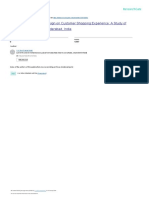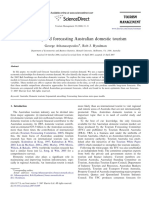Tutorial-Topic 2
Uploaded by
Aqim AzamTutorial-Topic 2
Uploaded by
Aqim AzamTUTORIAL 2 STA 570/572 TIME SERIES ANALYSIS AND FORECASTING
1. “Single exponential smoothing model has the advantage over moving average in that it has the
flexibility to provide weights according to the importance of the data”. Discuss and demonstrate
the truth of this statement.
2. Explain that for a certain value of 𝛼 the single exponential smoothing approaches the naïve model.
3. What is a “benchmark” model? Explain and give an example.
4. Use the data below to fit the following models. The first eight (8) observations are to be used to
estimate the model. Then, using the estimated models, generate the one-step-ahead forecasts for
periods 1988 till 1990. The models are:
i. Naïve Forecast
ii. Single exponential smoothing
iii. Linear regression trend fitting
1980 1981 1982 1983 1984 1985 1986 1987 1988 1989 1990
25 24 20 22 24 25 23 21 23 30 28
5. Write the necessary Excel instructions in the cells marked “?” in order to generate the error terms
for the models given below, assuming that the following table represents an Excel spreadsheet.
The bold alphabets indicate the columns. You are also to name the model used in each section.
𝑦𝑡
i. 𝐹𝑡+1 = (𝑦𝑡 𝑦 )
𝑡−1
Rows
A B C D E F
no.
1 t 𝑦𝑡 𝐹𝑡 𝜀1
2 1 𝑦1
3 2 𝑦2
4 3 𝑦3 ? ?
5 4 𝑦4
ii. 𝐹𝑡 = 𝛼𝑦𝑡 + (1 − 𝛼)𝐹𝑡−1 for 𝛼 = 0.8
Rows
A B C D E F
no.
1 t 𝑦𝑡 𝐹𝑡 𝜀1
2 1 𝑦1
3 2 𝑦2
4 3 𝑦3 ? ?
5 4 𝑦4
iii. 𝐴𝑡 = 𝛼𝑦𝑡 + (1 − 𝛼)(𝐴𝑡−1 + 𝑇𝑡−1 )
𝑇𝑡 = 𝛽(𝐴𝑡 − 𝐴𝑡−1 )(1 − 𝛽)𝑇𝑡−1
𝐹𝑡+𝑝 = 𝐴𝑡 + 𝑚 × 𝑇𝑡 for 𝛼 = 0.4, 𝛽 = 0.2 and m number of steps ahead forecast.
Rows
A B C D E F G
no.
1 t 𝑦𝑡 𝐴𝑡 𝑇1 𝐹𝑡+1 𝑒𝑡
2 1 𝑦1 ?
3 2 𝑦2 ? ? ?
4 3 𝑦3
5 4 𝑦4
6. How do you decide on the value of the parameter of an exponential model? Give two
examples that you can think of.
7. How do you determine the initial value of the exponential model?
8. Demonstrate the consequence of applying ‘small’ or ‘large’ parameter value in the
simple exponential model?
9. What is the implication of large 𝛼 in an exponential model?
10. For what use is the ‘hold-out’ data point?
11. In what way is the ARRES model different from other exponential models?
12. The application of statistical test procedure does not work in the exponential smoothing
modelling. Why?
You might also like
- 2025 Term 2 grade 7 Baseline Assessment (1)No ratings yet2025 Term 2 grade 7 Baseline Assessment (1)7 pages
- Sydney Grammar 2020 Year 10 Maths Yearly & SolutionsNo ratings yetSydney Grammar 2020 Year 10 Maths Yearly & Solutions34 pages
- E2.7 Sequences 4A Medium Topic Booklet 1 CIE IGCSE Maths - 1No ratings yetE2.7 Sequences 4A Medium Topic Booklet 1 CIE IGCSE Maths - 17 pages
- Grade 5 - Maths Mid-Term 1 Exam (2) .XLSX - Sheet1No ratings yetGrade 5 - Maths Mid-Term 1 Exam (2) .XLSX - Sheet12 pages
- MA 262, Spring 2018, Midterm 2 Version 01 (Green)No ratings yetMA 262, Spring 2018, Midterm 2 Version 01 (Green)7 pages
- Econometrics For Finance Assignment 2 2023 12-07-12!14!23100% (1)Econometrics For Finance Assignment 2 2023 12-07-12!14!233 pages
- June Controlled Test Grade 8 2024 Mokhari Secondary SchoolNo ratings yetJune Controlled Test Grade 8 2024 Mokhari Secondary School21 pages
- MSM 112 - Matrices and Its Applications-PppNo ratings yetMSM 112 - Matrices and Its Applications-Ppp84 pages
- University of Cambridge International Examinations Cambridge Checkpoint Paper 1 November 2005 1 HourNo ratings yetUniversity of Cambridge International Examinations Cambridge Checkpoint Paper 1 November 2005 1 Hour12 pages
- Grade 8 Mathematics MATH June Paper and Memo 2024 CHR SMI 2 SZXRXLNo ratings yetGrade 8 Mathematics MATH June Paper and Memo 2024 CHR SMI 2 SZXRXL16 pages
- Mr. Breitsprecher: Math Made Easy With Ms ExcelNo ratings yetMr. Breitsprecher: Math Made Easy With Ms Excel2 pages
- New 2013 Grade 6 Mathematics 2013 Test EngNo ratings yetNew 2013 Grade 6 Mathematics 2013 Test Eng15 pages
- Sciu-178 - Material Durante La Clase - U04No ratings yetSciu-178 - Material Durante La Clase - U049 pages
- Paper 2 Revision - Question 7's - QuestionsNo ratings yetPaper 2 Revision - Question 7's - Questions12 pages
- Paper 2 Revision - Question 7's - QuestionsNo ratings yetPaper 2 Revision - Question 7's - Questions12 pages
- grade-6-lesson-2-worksheet-2-patterning-problem-sheet-1No ratings yetgrade-6-lesson-2-worksheet-2-patterning-problem-sheet-12 pages
- Let's Practise: Maths Workbook Coursebook 6From EverandLet's Practise: Maths Workbook Coursebook 6No ratings yet
- Modelling Plume Rise and Dispersion From Pool FiresNo ratings yetModelling Plume Rise and Dispersion From Pool Fires10 pages
- 2009 - Tapp Dan Kemsley - Notes On The Practical Utility of OPLSNo ratings yet2009 - Tapp Dan Kemsley - Notes On The Practical Utility of OPLS6 pages
- The Effect of Foreign Direct Investment On Ethiopian Economic GrowthNo ratings yetThe Effect of Foreign Direct Investment On Ethiopian Economic Growth11 pages
- Factors Associated With Newborn Care Knowledge and Practices in The Upper HimalayasNo ratings yetFactors Associated With Newborn Care Knowledge and Practices in The Upper Himalayas18 pages
- Impact of Store Layout Design On Customer Shopping Experience: A Study of FMCG Retail Outlets in Hyderabad, IndiaNo ratings yetImpact of Store Layout Design On Customer Shopping Experience: A Study of FMCG Retail Outlets in Hyderabad, India16 pages
- Modelling and Forecasting Australian Domestic Tourism: George Athanasopoulos, Rob J. HyndmanNo ratings yetModelling and Forecasting Australian Domestic Tourism: George Athanasopoulos, Rob J. Hyndman13 pages
- PDF Time Series and Panel Data Econometrics First Edition M. Hashem Pesaran Download100% (5)PDF Time Series and Panel Data Econometrics First Edition M. Hashem Pesaran Download53 pages
- A Predictor For Movie Success: 2.1 Data CollectionNo ratings yetA Predictor For Movie Success: 2.1 Data Collection5 pages
- Evaluation of Tool Wear in EPB Tunneling of Tehran Metro, Line 7 ExpansionNo ratings yetEvaluation of Tool Wear in EPB Tunneling of Tehran Metro, Line 7 Expansion27 pages

























































































